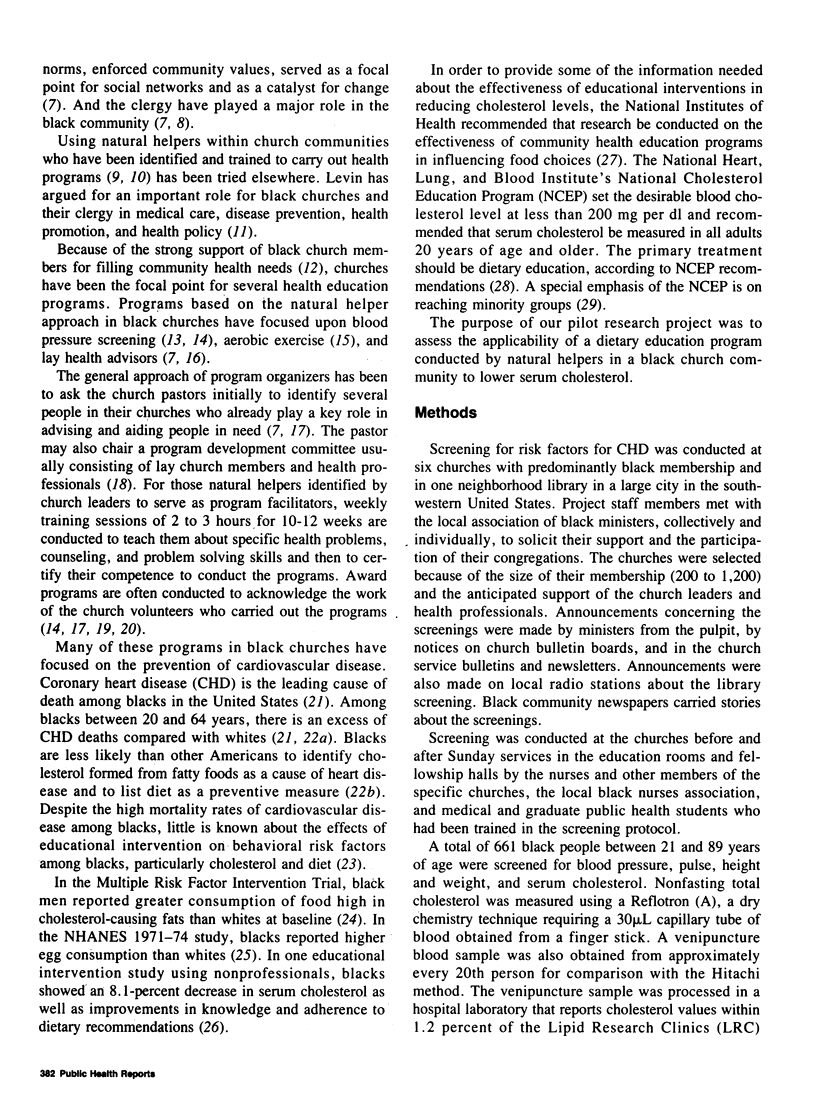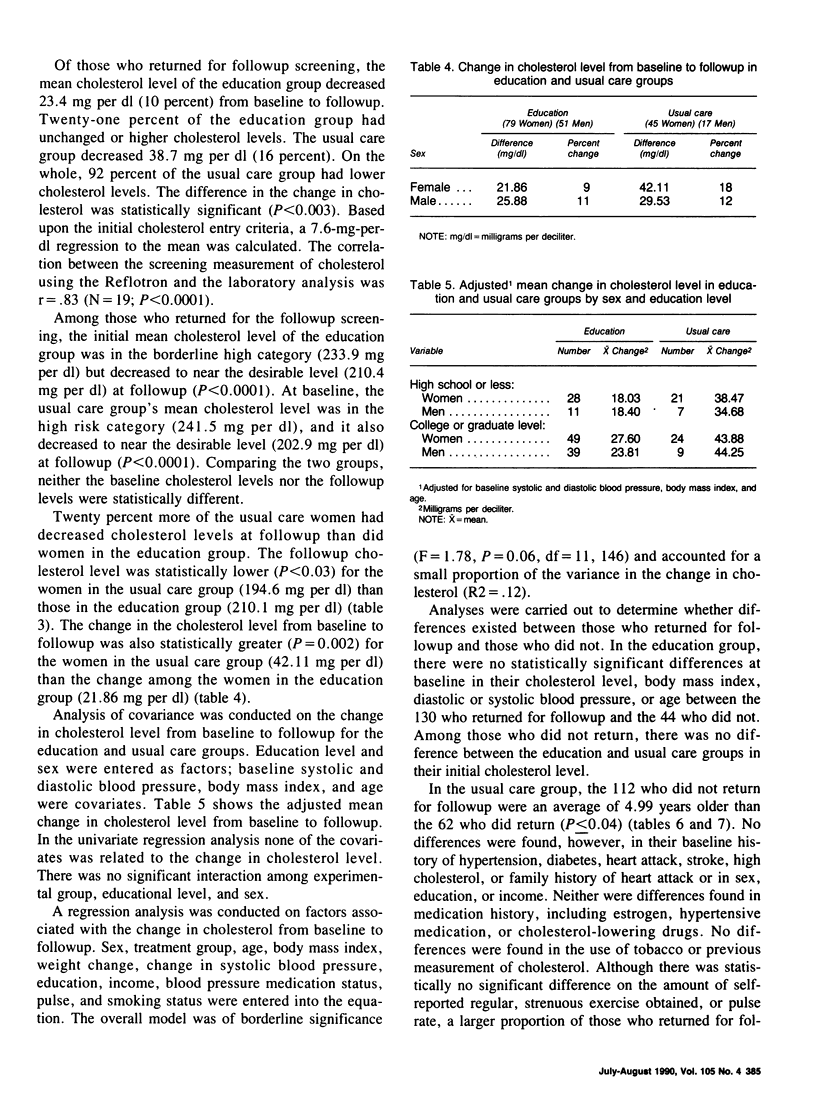Abstract
The leading cause of death among black people in the United States is coronary heart disease, accounting for about 25 percent of the deaths. The Task Force on Black and Minority Health formed by the Secretary of Health and Human Services in 1985 subsequently recommended increased efforts to reduce risk factors for coronary heart disease in the black population. A stated focus of the National Heart, Lung, and Blood Institute's National Cholesterol Education Program has been that of reaching minority groups. This report describes a pilot cholesterol education program conducted in black churches by trained members of those churches. Cholesterol screening, using a Reflotron, and other coronary heart disease risk factor screening was conducted in six churches with predominantly black members and at a neighborhood library. A total of 348 persons with cholesterol levels of 200 milligrams per deciliter (mg per dl) or higher were identified. At the time of screening, all were provided brief counseling on lowering their cholesterol and were given a copy of the screening results. Half of those identified, all members of one church, were invited to attend a 6-week nutrition education class of 1 hour each week about techniques to lower blood cholesterol. Information about cholesterol was also mailed to them. They were designated as the education group. Persons in the church were trained to teach the classes.(ABSTRACT TRUNCATED AT 250 WORDS)
Full text
PDF







Selected References
These references are in PubMed. This may not be the complete list of references from this article.
- Connett J. E., Stamler J. Responses of black and white males to the special intervention program of the Multiple Risk Factor Intervention Trial. Am Heart J. 1984 Sep;108(3 Pt 2):839–848. doi: 10.1016/0002-8703(84)90680-x. [DOI] [PubMed] [Google Scholar]
- Eng E., Hatch J., Callan A. Institutionalizing social support through the church and into the community. Health Educ Q. 1985 Spring;12(1):81–92. doi: 10.1177/109019818501200107. [DOI] [PubMed] [Google Scholar]
- Gillum R. F. American coronary primary prevention trials: implications for blacks. J Natl Med Assoc. 1986 Apr;78(4):267–269. [PMC free article] [PubMed] [Google Scholar]
- Gillum R. F. Coronary heart disease in black populations. I. Mortality and morbidity. Am Heart J. 1982 Oct;104(4 Pt 1):839–851. doi: 10.1016/0002-8703(82)90021-7. [DOI] [PubMed] [Google Scholar]
- Gillum R. F., Grant C. T. Coronary heart disease in black populations. II. Risk factors. Am Heart J. 1982 Oct;104(4 Pt 1):852–864. doi: 10.1016/0002-8703(82)90022-9. [DOI] [PubMed] [Google Scholar]
- Hatch J. W., Cunningham A. C., Woods W. W., Snipes F. C. The Fitness Through Churches project: description of a community-based cardiovascular health promotion intervention. Hygie. 1986 Sep;5(3):9–12. [PubMed] [Google Scholar]
- Hatch J. W., Renfrow W. C., Snider G. Progressive health education through community organization: a case study. Health Educ Monogr. 1978 Winter;6(4):359–371. doi: 10.1177/109019817800600403. [DOI] [PubMed] [Google Scholar]
- Israel B. A., Antonucci T. C. Social network characteristics and psychological well-being: a replication and extension. Health Educ Q. 1987 Winter;14(4):461–481. doi: 10.1177/109019818701400406. [DOI] [PubMed] [Google Scholar]
- Israel B. A., Hogue C. C., Gorton A. Social networks among elderly women: implications for health education practice. Health Educ Q. 1983 Fall-Winter;10(3-4):173–203. doi: 10.1177/109019818301000304. [DOI] [PubMed] [Google Scholar]
- Israel B. A. Social networks and social support: implications for natural helper and community level interventions. Health Educ Q. 1985 Spring;12(1):65–80. doi: 10.1177/109019818501200106. [DOI] [PubMed] [Google Scholar]
- Lasater T. M., Wells B. L., Carleton R. A., Elder J. P. The role of churches in disease prevention research studies. Public Health Rep. 1986 Mar-Apr;101(2):125–131. [PMC free article] [PubMed] [Google Scholar]
- Lenfant C. A new challenge for America: the National Cholesterol Education Program. Circulation. 1986 May;73(5):855–856. doi: 10.1161/01.cir.73.5.855. [DOI] [PubMed] [Google Scholar]
- Levin J. S. The role of the black church in community medicine. J Natl Med Assoc. 1984 May;76(5):477–483. [PMC free article] [PubMed] [Google Scholar]
- Minkler M. Applications of social support theory to health education: implications for work with the elderly. Health Educ Q. 1981 Summer;8(2):147–165. doi: 10.1177/109019818100800202. [DOI] [PubMed] [Google Scholar]
- Monahan J. L., Scheirer M. A. The role of linking agents in the diffusion of health promotion programs. Health Educ Q. 1988 Winter;15(4):417–433. doi: 10.1177/109019818801500404. [DOI] [PubMed] [Google Scholar]
- Olson L. M., Reis J., Murphy L., Gehm J. H. The religious community as a partner in health care. J Community Health. 1988 Winter;13(4):249–257. doi: 10.1007/BF01324237. [DOI] [PubMed] [Google Scholar]
- Saunders E., Kong B. W. A role for churches in hypertension management. Urban Health. 1983 May;12(5):49-51, 55. [PubMed] [Google Scholar]
- Zimmerman R. S., Connor C. Health promotion in context: the effects of significant others on health behavior change. Health Educ Q. 1989 Spring;16(1):57–75. doi: 10.1177/109019818901600108. [DOI] [PubMed] [Google Scholar]


